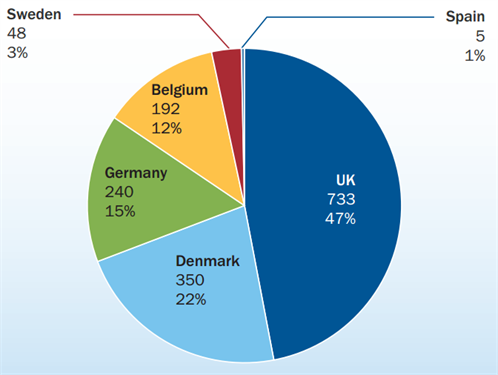Mat Hope
30.01.2014 | 11:20amThe UK was a world leader in offshore wind in 2013, but a new report casts doubt on how long that might last.
The research by industry group, the European Wind Energy Association (EWEA), shows the UK has the most offshore windfarms and turbines of any country in Europe. Moreover, almost half of the wind turbines installed in Europe last year were placed off the UK’s coast, according to the report.
But despite the new developments, the EWEA says the government’s current policies may slow the industry’s growth in 2014.
New capacity
Offshore wind is arguably one of the UK government’s renewable energy success stories.
According to the EWEA’s data, 47 per cent of new European offshore wind power was installed in the UK in 2013. Those turbines were added to what was already Europe’s largest offshore wind market.
As the pie chart below shows, companies installed more than twice the amount of offshore wind power in the UK than its nearest competitor, Denmark, in 2013:
Source: Share of annual offshore wind power installations per country (megawatts), The European offshore wind industry – key trends and statistics 2013, European Wind Energy Association
The government has been supporting renewable energy for decades, but last summer it announced changes to the way the industry would be subsidised.
In June, the government announced a new deal which guarantees renewable energy providers get paid a set amount for the electricity they produce until 2020. Offshore wind got a further boost in December, when the government announced it would be moving funds earmarked for solar and onshore wind subsidies across to its offshore cousin – effectively making offshore wind the government’s preferred renewable energy choice.
But despite the government’s continued support, the EWEA says offshore wind’s growth is starting to slow.
It’s data shows about 25 per cent less offshore wind power was installed in 2013 than a year before, with almost two-thirds of investment coming in the first half of the year.
Investor uncertainty
The EWEA says fewer projects were launched in 2013 “due to regulatory instability” in the UK. One reason for the slowdown is a lack of faith that the government’s current support will be sustained, the EWEA claims.
A Times article on the EWEA’s report pointed to two projects that were cancelled around the same time the government was considering reforming so-called green levies. Some papers suggested at the time that the uncertainty around the government’s policy reforms could have catalysed the cancellations.
But in both cases, the companies responsible for building the windfarms said the plans were pulled due to technical and environmental difficulties, not the government’s policy choices.
Nonetheless, the EWEA tells the Times that other government decisions may be putting off investors.
For instance, the EU recently announced it would not extend country-specific renewable energy targets after 2020 – a decision the UK government lobbied for.
Under current rules, the UK is required to get 15 per cent of its energy from renewable sources by 2020. But since the EU’s announcement, the government has made investors nervous by refusing to say how much renewable energy it will aim to develop post-2020.
The government’s pursuit of alternative energy forms such as shale gas and nuclear power may also lead investors to question the government’s long term commitment to offshore wind. The chancellor announced tax breaks for the shale gas industry in the autumn statement, and the government recently signed a landmark nuclear deal, which investors could take as a signal that the government’s preference for offshore wind is waning.
So while the UK currently leads the way in offshore wind power, investors are unclear how committed the government is to the technology in the long term – and the EWEA says that could halt offshore wind’s progress in 2014.


